11449 A NEOCLASSICAL POLYCHROME PAINTED SOFA DEPICTING TWO SCENES FROM HOMER’S ODYSSEY Mexican. First Quarter of The Nineteenth Century. Measurements: Height: 38″ (96.5 cm) Length: 70″ (177.8 cm) Depth: 29 1/2″ (74.9 cm).
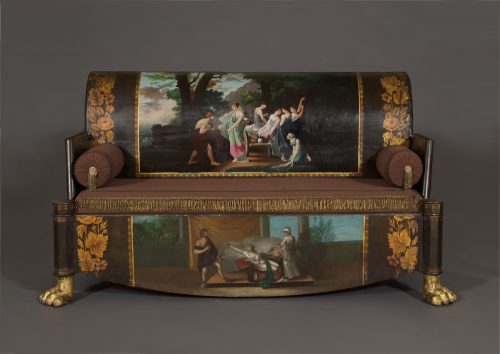
Research
Of polychrome painted wood. The rectangular outscrolled backrest centrally decorated with a mythological scene representing Odysseus landing on the island of Scheria, flanked by foliate borders, the rectangular armrests with confirming foliate border decoration above the rectangular frieze below the seat painted with another mythological scene representing Odysseus with Circe flanked by hexagonal shaped corners raised on giltwood paw feet. Roundels to the top of legs now lacking.
This rare and unusual sofa incorporates classical influences in both its form and decoration. Greek and Roman design influences that were disseminated throughout Europe, and its colonies, in the late eighteenth and nineteenth centuries inspired works with ancient forms, zoomorphic motifs and painted finishes, all manifested to varying degrees in the present sofa. Particularly interesting are the two painted mythological vignettes to the back and seat apron.
The scene depicted on the backrest of the sofa derives from an episode in the Odyssey in which Odysseus washes up on the shore of the island of Scheria, the home of the Phaeacians and their king, Alcinous; it was the final destination of his ten-year journey before returning to Ithaca. After Odysseus’ shipwreck, the goddess Athena appeared to Alcinous’ daughter, Nausicaa, in her sleep in the guise of a sea captain’s daughter, and instructed her to go to the seashore to wash her clothes. The next morning, Nausicaa and her maids go to the seashore, where their loud jovialities awaken Odysseus, who approaches them for help. Nausicaa gives him clothing and food and directs him to the palace. Ultimately, Odysseus recounts the stories of his adventures to Alcinous and his court, and the Phaeacians give him passage home on one of their ships.
The frieze below the seat on the present sofa is likewise painted with a scene from the Odyssey. In the chosen vignette Odysseus is confronted by Circe, a goddess of magic renowned for her knowledge of herbs and potions. She also possessed a magic staff that she used to transform adversaries into beasts. Before approaching Circe, Odysseus claims to have encountered Hermes, sent by Athena,who gives him a magic plant called molü that will render him immune to Circe’s potions, which we see Odysseus holding in the present interpretation, as Circe reaches out to offer him the goblet.
The sofa also takes an interesting form, whereby the design is dictated by its primary use as a vehicle for the painted classical imagery. Solid wood seat backs are very unusual on sofas and chairs and, in general, may be considered a conceit related to the gondola form of seating that existed in Russia in the early nineteenth century. The outscrolled shape of the back derives from ancient Roman lectus, or dining couch.
The narrow solid wood armrests are equally rare and distinctive as they are hinged, allowing their tilt to be regulated. This feature was first witnessed in England in the early 17th century on the celebrated “Knole Sofa” from Knole House in Kent circa 1635. Such a device is most uncommon, if not unique, in early nineteenth century seating.
A similar sofa (figure 1) was owned by the Spanish diplomat Salvador Bermúdez de Castro y Díez, 1st Marqués de Lema (1817–1883). Between 1845 and 1847 he served as the plenipotentiary minister in Mexico. This sofa is inscribed “E. Lazarin. Reparador de antiguedades. Mexico.“
Notably, this sofa features a classical scene across the backrest painted after Charles Meynier’s Departure of Telemachus (circa 1800), a painting lost for two centuries and only recently rediscovered in early 2018. Like the present sofa, this subject is taken from the Odyssey.
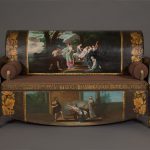

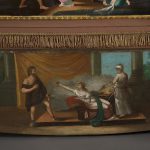
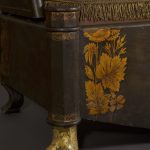
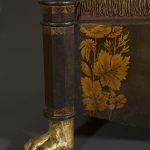

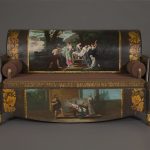
Comments are closed.